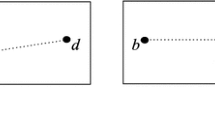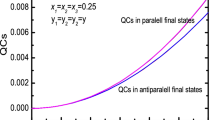Abstract
To generate long-distance shared quantum correlations (QCs) for information processing in future quantum networks, recently we proposed the concept of QC repeater and its kernel technique named QC swapping. Besides, we extensively studied the QC swapping between two simple QC resources (i.e., a pair of Werner states) with four different methods to quantify QCs (Xie et al. in Quantum Inf Process 14:653–679, 2015). In this paper, we continue to treat the same issue by employing other three different methods associated with relative entropies, i.e., the MPSVW method (Modi et al. in Phys Rev Lett 104:080501, 2010), the Zhang method (arXiv:1011.4333 [quant-ph]) and the RS method (Rulli and Sarandy in Phys Rev A 84:042109, 2011). We first derive analytic expressions of all QCs which occur during the swapping process and then reveal their properties about monotonicity and threshold. Importantly, we find that a long-distance shared QC can be generated from two short-distance ones via QC swapping indeed. In addition, we simply compare our present results with our previous ones.

Similar content being viewed by others
References
Ollivier, H., Zurek, W.H.: Quantum discord: a measure of the quantumness of correlations. Phys. Rev. Lett. 88, 017901 (2001)
Luo, S.L.: Quantum discord for two-qubit systems. Phys. Rev. A 77, 042303 (2008)
Luo, S.L.: Using measurement-induced disturbance to characterize correlations as classical or quantum. Phys. Rev. A 77, 022301 (2008)
Luo, S.L., Fu, S.S.: Geometric measure of quantum discord. Phys. Rev. A 82, 034302 (2010)
Modi, K., Paterek, T., Son, W., Vedral, V., Williamson, M.: Unified view of quantum and classical correlations. Phys. Rev. Lett. 104, 080501 (2010)
Dakic, B., Vedral, V., Brukner, C.: Necessary and sufficient condition for nonzero quantum discord. Phys. Rev. Lett. 105, 190502 (2010)
Girolami, D., Paternostro, M., Adesso, G.: Faithful nonclassicality indicators and extremal quantum correlations in two-qubit states. J. Phys. A Math. Theor. 44, 352002 (2011)
Zhou, T., Cui, J., Long, G.L.: Measure of nonclassical correlation in coherence-vector representation. Phys. Rev. A 84, 062105 (2011)
Zhang, Z.J.: Revised definitions of quantum dissonance and quantum discord. arXiv:1011.4333 [quant-ph]
Rulli, C.C., Sarandy, M.S.: Global quantum discord in multipartite systems. Phys. Rev. A 84, 042109 (2011)
Zhang, F.L., Chen, J.L.: Irreducible multiqutrit correlations in Greenberger–Horne–Zeilinger type states. Phys. Rev. A. 84, 062328 (2011)
Wei, H.R., Ren, B.C., Deng, F.G.: Geometric measure of quantum discord for a two-parameter class of states in a qubit–qutrit system under various dissipative channels. Quantum Inf. Process. 12, 1109 (2013)
Ali, M., Rau, A.R.P., Alber, G.: Quantum discord for two-qubit X states. Phys. Rev. A 81, 042105 (2010)
Hu, X.Y., et al.: Necessary and sufficient conditions for local creation of quantum correlation. Phys. Rev. A 85, 032102 (2012)
Shi, M., Sun, C., Jiang, F., Yan, X., Du, J.: Optimal measurement for quantum discord of two-qubit states. Phys. Rev. A 85, 064104 (2012)
Huang, Y.C.: Quantum discord for two-qubit X states: analytical formula with very small worst-case error. Phys. Rev. A 88, 014302 (2013)
Huang, Y.C.: Scaling of quantum discord in spin models. Phys. Rev. B 89, 054410 (2014)
Huang, Y.C.: Computing quantum discord is NP-complete. New J. Phys. 16, 033027 (2014)
Giorda, P., Paris, M.G.A.: Gaussian quantum discord. Phys. Rev. Lett. 105, 020503 (2010)
Hu, X., Fan, H., Zhou, D.L., Liu, W.M.: Quantum correlating power of local quantum channels. Phys. Rev. A 87, 032340 (2013)
Hu, M.L., Fan, H.: Upper bound and shareability of quantum discord based on entropic uncertainty relations. Phys. Rev. A 88, 014105 (2013)
Ye, B.L., Liu, Y.M., Chen, J.L., Liu, X.S., Zhang, Z.J.: Analytic expressions of quantum correlations in qutrit Werner states. Quantum Inf. Process. 12, 2355 (2013)
Tang, H.J., Liu, Y.M., Chen, J.L., Ye, B.L., Zhang, Z.J.: Analytic expressions of discord and geometric discord in Werner derivatives. Quantum Inf. Process. 13, 1331 (2014)
Li, G.F., Liu, Y.M., Tang, H.J., Yin, X.F., Zhang, Z.J.: Analytic expression of quantum correlations in qutrit Werner states undergoing local and nonlocal unitary operations. Quantum Inf. Process. 14, 559 (2015)
Xie, C.M., Liu, Y.M., Li, G.F., Zhang, Z.J.: A note on quantum correlations in Werner states under two collective noises. Quantum Inf. Process. 13, 2713 (2014)
Xie, C.M., Liu, Y.M., Xing, H., Chen, J.L., Zhang, Z.J.: Quantum correlation swapping. Quantum Inf. Process. 14, 653–679 (2015)
Madsen, L.S., Berni, A., Lassen, M., Andersen, U.L.: Experimental investigation of the evolution of Gaussian quantum discord in an open system. Phys. Rev. Lett. 109, 030402 (2012)
Lanyon, B.P., Jurcevic, P., Hempel, C., et al.: Experimental generation of quantum discord via noisy processes. Phys. Rev. Lett. 111, 100504 (2013)
Vogl, U., Glasser, R.T., Glorieux, Q., et al.: Experimental characterization of Gaussian quantum discord generated by four-wave mixing. Phys. Rev. A 87, 010101(R) (2013)
Benedetti, C., Shurupov, A.P., Paris, M.G.A., et al.: Experimental estimation of quantum discord for a polarization qubit and the use of fidelity to assess quantum correlations. Phys. Rev. A 87, 052136 (2013)
Madhok, V., Datta, A.: Interpreting quantum discord through quantum state merging. Phys. Rev. A 83, 032323 (2011)
Dakic, B., Lipp, Y.O., Ma, X., et al.: Quantum discord as resource for remote state preparation. Nat. Phys. 8, 666 (2012)
Li, B., Fei, S.M., Wang, Z.X., Fan, H.: Assisted state discrimination without entanglement. Phys. Rev. A 85, 022328 (2012)
Datta, A., Shaji, A., Caves, C.M.: Quantum discord and the power of one qubit. Phys. Rev. Lett. 100, 050502 (2008)
Maziero, J., Céleri, L.C., Serra, R.M., Vedral, V.: Classical and quantum correlations under decoherence. Phys. Rev. A 80, 044102 (2009)
Streltsov, A., Kampermann, H., Bruss, D.: Behavior of quantum correlations under local noise. Phys. Rev. Lett. 107, 170502 (2011)
Ciccarello, F., Giovannetti, V.: Creating quantum correlations through local nonunitary memoryless channels. Phys. Rev. A 85, 010102(R) (2012)
Acknowledgments
This work is supported by the National Natural Science Foundation of China under Grant Nos. 11375011 and 11372122, the Natural Science Foundation of Anhui Province under Grant No. 1408085MA12, the Program for Excellent Talents at the University of Guangdong Province (Guangdong Teacher Letter [1010] No. 79), and the 211 Project of Anhui University.
Author information
Authors and Affiliations
Corresponding author
Appendices
Appendix 1
Theorem
If two bipartite states can be converted mutually via single-partite unitary operations, then they are equivalent in the sense of calculating total, quantum and classical correlations with each of the three methods. To be specific, if \(\rho _{ab} = u_a v_b \rho _{ab}' u_a^\dag v_b^\dag \), where u and v are unitary operators, then \(T[\rho _{ab}] = T[\rho '_{ab}], D_\mathrm{M}[\rho _{ab}] = D_\mathrm{M}[\rho _{ab}'], C_\mathrm{M}[\rho _{ab}] = C_\mathrm{M}[\rho _{ab}'], D_\mathrm{Z}[\rho _{ab}] = D_\mathrm{Z}[\rho _{ab}'], C_\mathrm{Z}[\rho _{ab}] = C_\mathrm{Z}[\rho _{ab}'], D_\mathrm{R}[\rho _{ab}] = D_\mathrm{R}[\rho _{ab}']\), and \(C_\mathrm{R}[\rho _{ab}] = C_\mathrm{R}[\rho _{ab}']\).
Proof
For a bipartite state, its product state is determined. Hence, its total correlations estimated in the three methods are equal to each other according to the definition. Since \(\rho _{ab} = u_a v_b \rho _{ab}' u_a^\dag v_b^\dag \), in terms of Eqs. (5), (10) and (1) as well as the trace property of von Neumann entropy one can derive
In terms of the classical state definition given in Eq. (2) and Eqs. (30–32), one knows that, if \(\chi [\rho _{ab}]\) is a classical state of \(\rho _{ab}\), then \(u_a^\dag v_b^\dag \chi [\rho _{ab}]v_b u_a \) is a classical state of \(\rho '_{ab}\), and vice versa. That is to say,
Using the definition of quantum discord given by Eq. (11) and the equality above, one can get
Meanwhile, one can further obtain
According to the definition of classical correlation given by Eq. (12) in the MPSVW method, one is readily to have
From Eq. (93), one can further get
Using the definition of the exact classical correlation given in Eq. (15), one can obtain
At the same time, one can arrive at
Utilizing Eqs. (16) and (99), one gets
As has been stressed in Eq. (19), \(C_\mathrm{R}[\rho _{ab}]\) equals to \( C_\mathrm{Z}[\rho _{ab}] \). Hence, according to \(C_\mathrm{Z}[\rho _{ab}] = C_\mathrm{Z}[\rho _{ab}']\), one can directly get \(C_\mathrm{R}[\rho _{ab}] = C_\mathrm{R}[\rho _{ab}']\). Moreover, according to the definition in Eq. (20), one obtains
\(\square \)
Corollary
In the case of \(\rho _{ab} = u_a v_b \rho _{ab}' u_a^\dag v_b^\dag \) with u and v being unitary operators, \(L_\mathrm{M}[\rho _{ab}] = L_\mathrm{M}[\rho _{ab}']\) and \(L_\mathrm{Z}[\rho _{ab}] = L_\mathrm{Z}[\rho _{ab}']\).
Proof
Using \(T[\rho _{ab}] = T[\rho '_{ab}], D_\mathrm{M}[\rho _{ab}] = D_\mathrm{M}[\rho _{ab}']\) and \(C_\mathrm{M}[\rho _{ab}] = C_\mathrm{M}[\rho _{ab}']\) as well as the additivity relation given in Eq. (14), one can easily get \(L_\mathrm{M}[\rho _{ab}] = L_\mathrm{M}[\rho _{ab}']\). Similarly, in terms of \(T[\rho _{ab}] = T[\rho '_{ab}], D_\mathrm{Z}[\rho _{ab}] = D_\mathrm{Z}[\rho _{ab}'], C_\mathrm{Z}[\rho _{ab}] = C_\mathrm{Z}[\rho _{ab}']\) and the additivity relation shown in Eq. (18) as well, one is readily to obtain \(L_\mathrm{Z}[\rho _{ab}] = L_\mathrm{Z}[\rho _{ab}']\). \(\square \)
Appendix 2
Partial derivatives in Sect. 3.2 in MPSVW method.
If \((\alpha _1, \alpha _2, \omega )=(0,0,0) \) or \((\frac{\pi }{4},\frac{\pi }{4},0) \), then \(\frac{\partial S\{\chi [{\rho _{yz}^e}]\} }{\partial \alpha _2}=0, \frac{\partial S\{\chi [{\rho _{yz}^e}]\} }{\partial \alpha _2}=0\) and \(\frac{\partial S\{\chi [{\rho _{yz}^e}]\} }{\partial \omega }=0\).
Appendix 3
Partial derivatives in Sect. 3.2 in Zhang method.
Obviously, \(\frac{\partial \mathcal {C}}{\partial \alpha _1}=\frac{\partial }{\partial \alpha _2}=\frac{\partial \mathcal {C}}{\partial \omega }=0\) in the case that \((\alpha _1, \alpha _2, \omega )=(0,0,0) \) or \((\frac{\pi }{4},\frac{\pi }{4},0)\).
Appendix 4
Explanation of quantity \(L_Z[\rho _{ab}]\).
According to Eqs. (8) and (17), one can get
Since \(S\{\pi [\chi ^Z[\rho _{ab}]]\}\) and \(S\{\pi [\rho _{ab}]\}\) can be expressed as
combining Eqs. (108) and (109), one can get
Further, let
easily one can see that \(L_a^Z\) actually denotes the uncertainty information in the particle a associated with the appropriate classical state \(\chi ^Z[\rho _{ab}]\) and \(L_b^Z\) represents that in the particle b. In this situation, for the bipartite quantum state \(\rho _{ab}\), the quantity
just represents the sum of uncertainty information of single particle a and that of b.
Rights and permissions
About this article
Cite this article
Xie, C., Liu, Y., Chen, J. et al. Study of quantum correlation swapping with relative entropy methods. Quantum Inf Process 15, 809–832 (2016). https://doi.org/10.1007/s11128-015-1209-4
Received:
Accepted:
Published:
Issue Date:
DOI: https://doi.org/10.1007/s11128-015-1209-4




